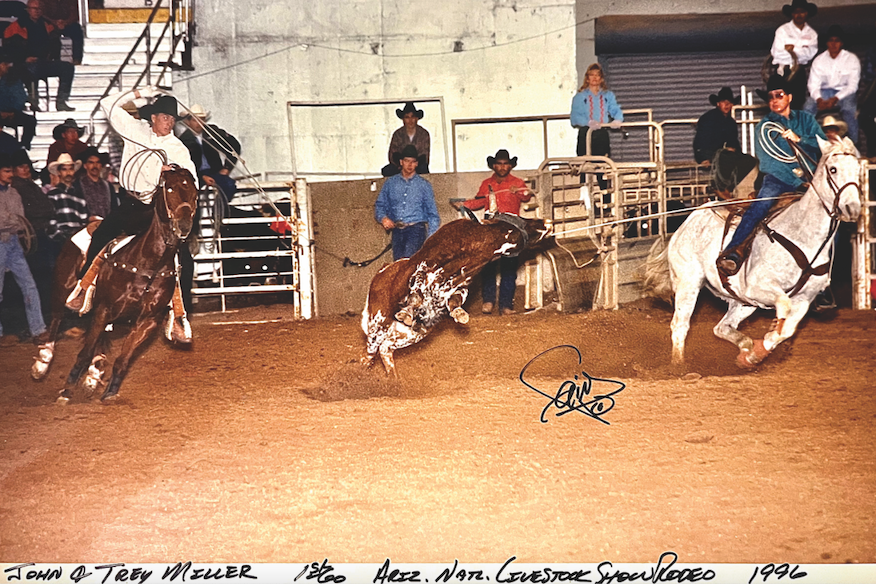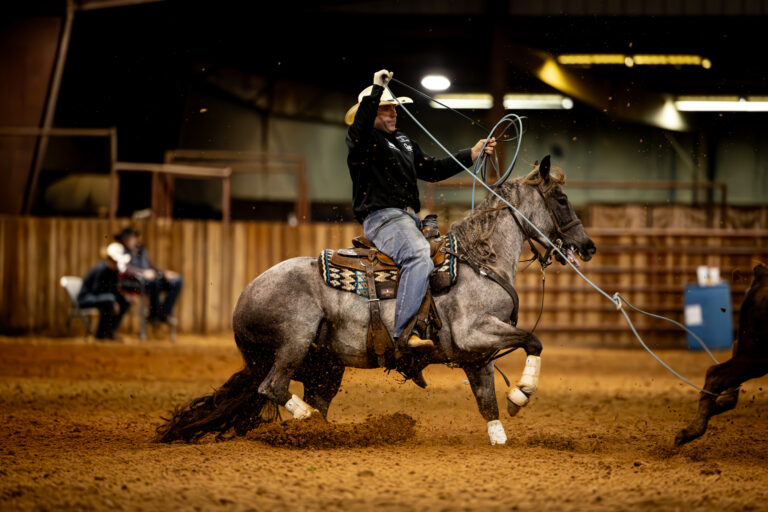The American Rope Horse Futurity Association jumped onto the scene in 2017 with the first event held in Fort Worth alongside the NRCHA’s Snaffle Bit Futurity. But for decades prior, those passionate about great horses had been toiling in arenas across the country, preparing for their chance to shine…
Full Results from the 2023 ARHFA World Championships

“Dang, I wish this could have gotten started a little earlier,” said one of the greatest rope-horse producers of all time.
Bobby Lewis was talking about the explosion of rope horse futurities recently with some other industry veterans. In fact, Lewis did train 4-year-old rope horses 45 years ago, and even won futurities. But there were no five-figure paydays. They didn’t survive the USTRC. And they’re nowhere on the internet.
The hands-down hotbed of young rope horses in the 1970s and ’80s was Nebraska. Howard Pitzer’s sandhills-raised Two Eyed Jack babies were in demand and dominated 4-and-under competitions. Trainers then put horses in the AQHA’s roping classes to pad cumulative year-end point totals in hopes of winning a new Jeep Wagoneer to hook onto their bumper-pull. But futurities were solely to promote bloodlines.
That’s why Pitzer launched one of the first team roping futurities in Grand Island, Nebraska, in the 1970s, to go along with the AQHA futurities in other events. It prompted the giant Silver Classic show at Omaha’s Ak-Sar-Ben Coliseum to start having one, too.
“We took about 20 head of horses from Haythorns to the Ak-Sar-Ben futurity,” recalled Jerry Buckles, who headed for Jerold Camarillo as a rookie at the 1985 NFR.
Buckles and Kent Martin were dominating the Nebraska amateur rodeos then. And in the early ’80s, Marty Johnson won the Ak-Sar-Ben futurity at both ends and good money on his mother Wanda’s mare, Dixie Anna Flash, with Billy Gallino helping. Lewis, who also once won the Ak-Sar-Ben futurity, said it suffered from a lack of following because there just weren’t enough trainers to justify adding money.
“Back then, there were only so many ropers who wanted to be judged,” pointed out Pitzer’s grandson, Jim Brinkman. “Futurities were limited to the roughly 50 horse show guys in the country.”
J.D. Yates and Justin Johnson among other rodeo-champs-turned-trainers were just young upstarts. The winners on 4-year-olds then were guys like the late Billy Allen and Sunny Jim Orr.
“Sunny Jim trained so many great horses,” recalled NFR heeler and BFI champ Jay Wadhams. “And Leroy Webb, who worked for Wiescamps, is about to celebrate his 90th birthday. Jack Kyle. They were all cowboys. Not just horse trainers—they were cowboys.”
A 23-year-old Yates won his first Junior AQHA world title heeling on a 4-year-old in 1984 after he’d already been to nine NFRs. Lewis scored his first Junior win on a colt in ’86.
“We started a futurity in Houston,” recalled ProRodeo Hall-of-Famer John Miller, tapped by Ed Gaylord to train his Lazy E horses. “And it wasn’t just Quarter Horses; we took whatever wanted to come. I also put on a futurity there at the E, to showcase our horses.”
Locales of other early futurities included Wichita, Kansas; Scottsdale, Arizona; and southwest Oregon. Miller also recalls one at the Rose Palace in San Antonio.
“Those 4-and-under roping futurities in Oregon were added to the reining and pleasure futurities,” recalled reined-cow-horse superstar Bob Avila, who won a few of them with Wadhams or Yates helping. “They gave saddles and buckles and paid good.”
Miller also hired Wadhams and Yates to show Lazy E horses, and he’d pay them depending on the points they earned. Rodeo GOATs including Leo Camarillo, Clay Cooper, Tee Woolman and Mike Beers were hired to ride the babies at the World Show in Oklahoma City.
Original Junior Blood

Pitzer’s standout 4- and 5-year-olds by Two Eyed Jack won several Junior AQHA world titles over two decades under Billy Allen—except in ’78 when the win at both ends went to the standout 3-year-old Grey Lark under Oscar Crigler for Ben Johnson. The grey was by a full Thoroughbred stallion out of a Tonto Bars Gill granddaughter. Johnson’s nephew, John Miller, credits Oklahoma’s Bill Rowe for that specimen.
“Bill was the smartest horseman I’ve ever seen as far as breeding and crossing on mares—along the lines of Matlock Rose or Walter Merrick,” Miller said.
In 1983, Pitzer’s 4-year-old Two ID Bartender won the Junior World on both ends with Gary Putnam aboard.
“I would say Gary’s one of the greatest rope horse trainers of all time, and never really got that recognition,” said five-time NFR header Jay Ellerman. “He was one of only three guys to ever win the heading and heeling on the same Junior horse at the World Show.”
And that bloodline has persisted 40 years, considering Wadhams’ 2013 AQHA Senior Heeling world titlist was Two ID Shooter Buck, and Colby Lovell’s 2020 PRCA gold buckle came courtesy of a reported Two ID Bartender descendant.
The biggest bloodline of great colts in the 1980s, though, was Zan Parr… anything. Carol Rose began crossing Two Eyed Jack and Diamonds Sparkle mares on her AQHA Hall-of-Fame rope horse Zan Parr Bar. In 1984, a son named Zan Parr Jack went home with Gaylord, who put him under Miller and Yates. The 4- and 5-year-old offspring of that stud soon won four different Junior world titles, mostly under Lewis.
“They were doggone good using horses,” said Miller. “You could head, heel or rope calves on them, plus reining and cowhorse. I had some really good 4-year-olds. In the early ’80s, I sold a Zan Parr Jack gelding for $17,000, which was unheard of at the time.”
Growing Pains for Rope Horse Futurities

But futurities remained isolated. In the 1990s, as Brinkman pointed out, the business model of the jackpots was to run a team every 40 seconds and keep a third of the money. So judged events with meager added money never grew.
In 2007, Jay and Lindsay Wadhams began hosting sporadic, judged-only futurities in places like Salado and Stephenville, Texas. Meanwhile, Sonny and Darlene Miller were still working on launching the National Team Roping Horse Association, modeled after cutting’s NCHA but incorporating times into the scores. They planned to add futurities following their inaugural 2008 events. They published a magazine to promote breeders and trainers and hired John Miller to train judges.
“I gave my heart and soul to that thing for a year and a half,” he said of the NTRHA, which went bankrupt in 2009. “We wrote rules that futurities still use, and I hired and trained 35 rope horse judges, many of whom are still judging. The guys we used were horsemen. They knew how horsemen were supposed to do it.”
The first NTRHA event in 2008 drew 100 entries and paid $27,185 in Open, Limited Open, Amateur, Novice Amateur and Youth classes. The intent of the NTRHA was to promote breeders and trainers instead of just stallions. With time factored in and hard-running cattle, it was a true showcase.
“That was the trouble with horse shows,” said Brinkman. “The conditions were always soft and the cattle always average, so everybody had a great run.”
While the Millers were draining their finances, Wadhams was inching along with his judged ARHFA events, courtesy of sponsored facilities and money added by people like Brinkman.
“We didn’t have enough money to draw ropers,” recalled Wadhams. “It was rough. We were just drawing the horse show crowd and they were our only sponsors. But as soon as we started incorporating time, that’s when people showed interest. It was timed-event horses the public wanted to buy, so that’s what we needed to be training. Then, the money is what really changed things.”
He’s talking about Dean Tuftin’s partnership, which financially made possible the first ARHFA World Championships a decade after Wadhams started. Tuftin’s end goal was that, someday, rope horse trainers could make a living doing only that. Ellerman, like Wadhams, thinks it would have been very tough to see what’s happened over the past seven years without the essential backing of Tuftin. Also instrumental was their decision to hold the event in conjunction with the NRCHA’s Snaffle Bit Futurity.
“Going to Fort Worth during the Snaffle Bit was a great way to have that Finals,” said Rick Chayer, who trained rope horses for decades for several top breeders. “He got people who don’t know much about the rope horses mingling and talking to each other. Now, some of the cowhorse boys have started showing in the roping futurity a little bit. And during the Snaffle Bit sale, ropers were eyeballing roping prospects instead of them all becoming cow horses. It worked out really good for both disciplines.”
Recent Decades

In this century, Zan Parr Jack was still producing. His grandson, With All Probability, became the 2005 Superhorse and won at both ends under Kory Koontz and trainer Brad Lund. Then of course, 5-year-old Im Brad To The Bone—a grandson of With All Probability—kicked off today’s insanely high auction prices for rope horses in 2018 when he brought $79,000 at Rancho Rio.
Shining Spark blood became popular for roping prospects in 2000 when Miss N Shine won the Junior Heading under Woolman for Carol Rose. It really gained steam when Rose came up with Smart Nu Shiner. He was bred to a daughter of With All Probability to get Probably A Shiner—the stud that not only won last year’s Royal Crown futurity at 5, but also the AQHA Junior heading and heeling world titles under Yates.
Plus, Dean Tuftin’s 2019 PRCA/AQHA Heel Horse of the Year DT Sugar Chex Whiz is a granddaughter of Shining Spark. “Sugar” is also the dam of the current futurity-winning and syndicated stallion The Darkk Side. Even Rhen Richard’s Chics Magic Corona, the defending ARHFA heading futurity champ, is a grandson of a Shining Spark daughter.
“Shining Spark was a hell of a producer, and so was High Brow Cat,” said Miller. “Those offspring are really, really athletic horses, and seem to be trainable; just unbelievable-minded. They may not be racehorses, but can catch up. And look really good doing it.”
In seven years, the ARHFA World Championships has gone from one long 17-hour day with a payout of less than $300,000 to eight ropings over four days with a potential cash-and-prize payout at press time of $1 million.
“I just took what I learned from rodeoing and horse-showing and threw it all together,” Wadhams said. “I saw the need for this but had no idea it would do what it’s done.”
What it’s done, too, is spawned four competing futurity producers whom Wadhams has welcomed by sending staff to their events, respecting their dates and collaborating on incentives. The domino effect in the team roping industry has gavels dropping on six-figure horses, 4-year-olds working like they’re 6, and breeders scrambling to specialize (even gold-buckle greats Kaleb Driggers and Clay Smith own stallions now).
So, what tipped the scales after futurities floundered for 50 years?
“Jay is a smart guy, a hard worker and does what he says he’ll do,” said Miller. “For me, that’s a route to success.”
The Incentive winner at that very first ARHFA World Championships was, of course, Lewis, roughly 40 years after he won that Ak-Sar-Ben futurity. Perennially tough to beat, the NCHA Hall-of-Famer and former World’s Greatest Horseman banked $7,000 that day heading on 4-year-old Dual Patron.
“I just hope this continues,” Lewis said. “Good guys are putting rope horse futurities on and running good shows. I’m so glad it got cranked up and going. It’s good for everybody involved and raising these horses.” TRJ











